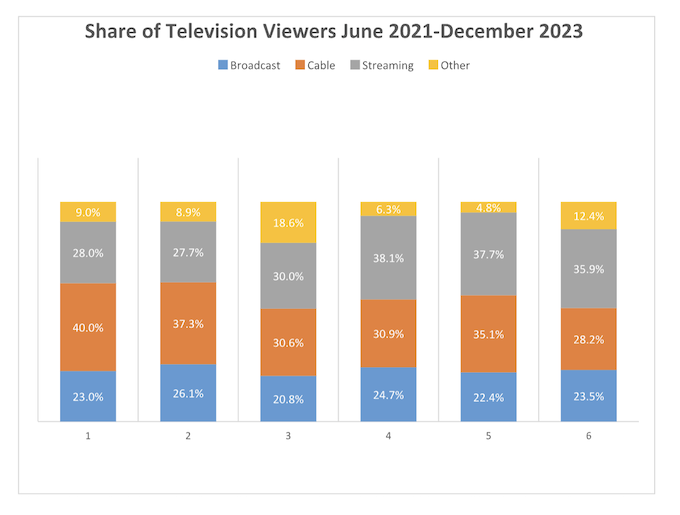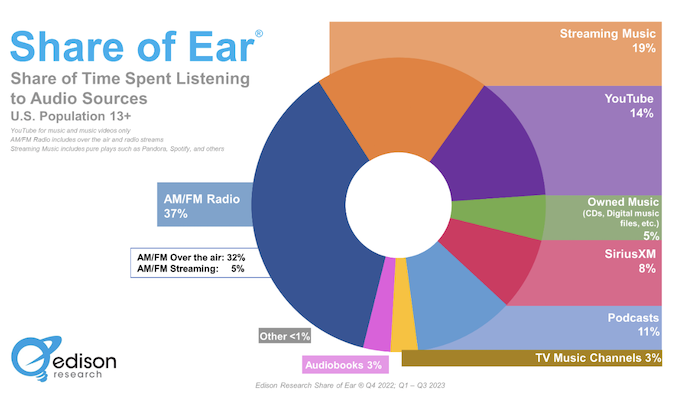By Steve Edelman, President, Connect360
The answer to “Do people still watch TV?” is a simple one. They definitely do. In fact, Americans appear to have an insatiable appetite for entertainment and information. According to Nielsen, total television viewership continued to grow in 2023, with people watching an average of 33 hours of television a week.
In February 2023, 115 million Americans watched the Kansas City Chiefs play the Philadelphia Eagles in the Super Bowl. It was the most watched Super Bowl ever. Reaching 35% of the population of the country put it among the top-three most watched broadcast television programs in history.
Of course, the Super Bowl is a once a year event. We need more data to show that there are still plenty of Americans watching television.
How about news?
During 2023, Fox News was America’s most watched cable network by far. It averaged an audience of 1.85 million viewers in primetime. Then there was Suits, a multi-part dramatic series that ran on Netflix in 2023. It finished among the most-viewed shows on streaming TV for a record 12 consecutive weeks, reaching between 2.5 and 3.5 million viewers each week.
These example span all three ways that people watch television today: broadcast, cable and streaming. So the question is not “do people still watch TV” what we should be asking is: “how are they watching?”
How TV Has Changed Over Time
The world of television as we knew it just ten years ago has changed dramatically. Back then, broadcast and cable accounted for nearly 100% of television viewing hours. The wide adoption of smart television sets and connected TV changed all that. In the mid-2000s, smart televisions became popular features in American homes. Today, according to Nielsen, more than 70% of U.S. households that own a TV have a Smart TV compared to about 62% just two years ago.
Then, in March 2020, along came COVID. People were stuck at home with little else to do but watch TV. Ratings went up, but more importantly, people had time to binge watch streaming television. Television-watching behavior changed as people shifted their viewing hours to spend more time on streaming and less on broadcast and cable.
Streaming viewership grew; people signed up for paid subscriptions so they could keep up with their favorite shows. Many decided to give up their cable contracts to save money. Cord-cutting became a common buzzword.
Television viewership changed so radically that Nielsen had to come up with a new way to measure it. In 2021, they created a new metric called “viewer hours” which measured how many hours the country spent watching television and what share of these hours each medium received.
How are Americans watching television today?
The chart below shows the share of time that viewers spent watching each of the three major formats in December 2023. Streaming took the lead, capturing 35.9% of total viewer hours. This was followed by cable at 28.2%, and broadcast at 23.5%.
Together, broadcast and cable, which primarily deliver content in a linear format on a set schedule, received a total of 51.7% of total viewer hours. Across streaming platforms, YouTube and Netflix are the most watched, receiving 8.5% and 7.7% of viewer hours respectively.
The chart below shows how share-of-viewing hours changed between 2021 and 2023 according to Nielsen data. Streaming grew from 28% of total viewing hours in June of 2021 to almost 36% in December 2023. Broadcast bounced around, but ended up back where it started at about 23%. Cable took the biggest hit, dropping from 40% of viewing hours in June 2021 to just over 28% by December 2023
 The future of streaming looks uncertain
The future of streaming looks uncertain
This year, streaming started to run into some headwinds. People have realized that maintaining multiple streaming subscriptions is expensive. Some who had migrated from cable hoping to save money now found that subscription fees were eating into the savings. Then, Netflix and others started to crackdown on people sharing subscription accounts. At the same time, fewer new shows were coming out on streaming platforms, and those that did, had fewer episodes.
In October, 20% of survey respondents told Nielsen that there were times they couldn’t find anything to watch on streaming. All of these factors contributed to subscription fatigue. This is a key problem that streaming platforms know they have to solve.
Many smart consumers developed strategies to save money. One study by Peak Associates found that 20% of connected households had a TV antenna and 12% of those who did not were considering buying one in the next six months. Others learned how to bounce between streaming services each month based on who had the most desirable new shows coming up. As a result, streaming networks saw an increase in churn rates. Given the expense of recruiting new subscribers, this became an expensive problem.
Streaming networks are finding it difficult to grow their subscriber number enough to cover the huge investment of creating new content. Their current answer is to introduce advertising — something they hope will not alienate their viewers. The future of streaming will include even more changes as platforms look for ways to keep subscribers for the long-haul.
Good news (and sports) for the future of television
Clearly, television viewers like what they see on streaming, but it isn’t fulfilling all of their viewing needs. They keep tuning in to broadcast and cable for news, especially local news, and sports. Older audiences have been slower to adopt streaming as well. The net result was that the rush to streaming dropped to a trickle in 2023. Cable’s drop in viewers slowed and all three mediums have found a way to coexist.
Despite the challenges posed by streaming, the future of television is looking up. In the coming months and years, they will be heavily promoting the introduction of new NextGen technology that Sony and other television manufacturers are building into their devices. It will allow over-the-air free television to have many of the features streaming currently provides including: on-demand capabilities, enhanced video and audio, and interactive features for in-show shopping.
How has streaming TV impacted Public Service Announcements?
As the owner of a company that distributes public service announcements, I look at changes in the world of television though a very specific prism: How do they affect PSAs?
At this point, all television PSAs air on broadcast and cable television. Although streaming television has captured a big share of viewer hours from broadcast and cable TV, PSAs have not yet found their way onto streaming platforms. This may change as more streaming networks start to air paid advertising. They may see PSAs as a way to improve brand images that have been damaged by recent changes to programming and subscription plans.
In reviewing how PSAs performed in recent years, I noticed two interesting things happening. First, Nielsen found that PSA broadcast and cable airings in 2022 were the highest in history and early information indicates that 2023 could be still higher. Second, the average audience for these airing has remained relatively constant. On broadcast, this constancy is consistent with Nielsen’s viewership statistics. For cable, PSAs continue to air heavily on news channels and during sports events, especially regional sports.
Therefore, coming into 2024, the outlook for Public Service Announcements is good. PSAs are likely to reach at least as many viewers as they did in 2023. In fact, viewership might actually increase because we’re in an election year. If 2024 follows trends we saw in the 2020 presidential election, airings might decline a bit during the months of September to November, but average impressions will increase as viewers turn to linear news and sports channels.
So, do people still watch TV?
The answer is definitely, yes, people do still watch TV. Though audiences may be watching in new ways, television is here to stay. Americans are settling into patterns of TV viewership split evenly across broadcast, cable and streaming platforms.
Given this new paradigm, nonprofit organizations that are looking to reach broad national audiences for their awareness campaigns should continue to make Public Service Announcements a key part of their marketing plans in 2024.
Want to learn more about PSAs? Our article on How to Get Your Public Service Announcement on TV is a great place to start.
Connect360 is a Capitol Communicator sponsor.


























0 Comments